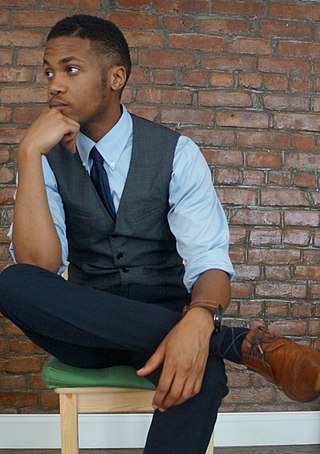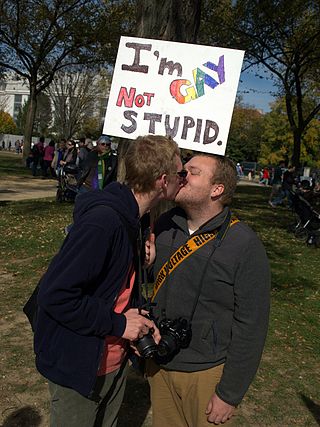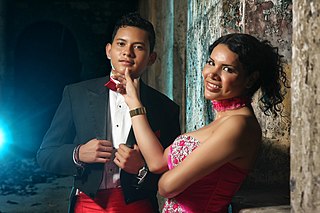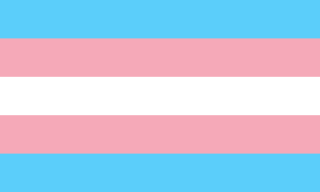Related Research Articles

Butch and femme are masculine (butch) or feminine (femme) identities in the lesbian subculture that have associated traits, behaviors, styles, self-perception, and so on. This concept has been called a "way to organize sexual relationships and gender and sexual identity". Butch–femme culture is not the sole form of a lesbian dyadic system, as there are many women in butch–butch and femme–femme relationships.
Femme is a term traditionally used to describe a lesbian woman who exhibits a feminine identity or gender presentation. While commonly viewed as a lesbian term, alternate meanings of the word also exist with some non-lesbian individuals using the word, notably some gay men and bisexuals. Some non-binary and transgender individuals also identify as lesbians using this term.

Non-binary and genderqueer are umbrella terms for gender identities that are outside the male/female gender binary. Non-binary identities often fall under the transgender umbrella since non-binary people typically identify with a gender that is different from the sex assigned to them at birth, although some non-binary people do not consider themselves transgender.

"Lipstick lesbian" is slang for a lesbian who exhibits a great amount of feminine gender attributes, such as wearing make-up, dresses or skirts, and having other characteristics associated with feminine women. In popular usage, the term is also used to characterize the feminine gender expression of bisexual women, or the broader topic of female–female sexual activity among feminine women.
LGBTQ slang, LGBTQ speak, queer slang, or gay slang is a set of English slang lexicon used predominantly among LGBTQ people. It has been used in various languages since the early 20th century as a means by which members of the LGBTQ community identify themselves and speak in code with brevity and speed to others.

A trans man is a man who was assigned female at birth. Trans men have a male gender identity, and many trans men undergo medical and social transition to alter their appearance in a way that aligns with their gender identity or alleviates gender dysphoria.
Effeminacy or male femininity is the embodiment of feminine traits in boys or men, particularly those considered untypical of men or masculinity. These traits include roles, stereotypes, behaviors, and appearances that are socially associated with girls and women. Throughout Western civilization, men considered effeminate have faced prejudice and discrimination. Gay men are often stereotyped as being effeminate, and vice versa. However, femininity, masculinity, and other forms of gender expression are independent of sexual orientation.

Terms used to describe homosexuality have gone through many changes since the emergence of the first terms in the mid-19th century. In English, some terms in widespread use have been sodomite, Sapphic, Uranian, homophile, lesbian, gay, and queer. Some of these words are specific to women, some to men, and some can be used of either. Gay people may also be identified under the umbrella term LGBT.
Gender expression, or gender presentation, is a person's behavior, mannerisms, and appearance that are socially associated with gender, namely femininity or masculinity. Gender expression can also be defined as the external manifestation of one's gender identity through behavior, clothing, hairstyles, voice, or body characteristics. Typically, a person's gender expression is thought of in terms of masculinity and femininity, but an individual's gender expression may incorporate both feminine and masculine traits, or neither. A person's gender expression may or may not match their assigned sex at birth. This includes gender roles, and accordingly relies on cultural stereotypes about gender. It is distinct from gender identity.

Sexual attraction to transgender people has been the subject of scientific study and social commentary. Psychologists have researched sexual attraction toward trans women, trans men, cross dressers, non-binary people, and a combination of these. Publications in the field of transgender studies have investigated the attraction transgender individuals can feel for each other. The people who feel this attraction to transgender people name their attraction in different ways.
A soft butch, or stem (stud-fem), is a lesbian who exhibits some stereotypical butch traits without fitting the masculine stereotype associated with butch lesbians. Soft butch is on the spectrum of butch, as are stone butch and masculine, whereas on the contrary, ultra fem, high femme, and lipstick lesbian are some labels on the spectrum of lesbians with a more prominent expression of femininity, also known as femmes. Soft butches have gender expressions of women, but primarily display masculine characteristics; soft butches predominantly express masculinity with a touch of femininity.

LGBTQ stereotypes are stereotypes about lesbian, gay, bisexual, transgender, and queer (LGBTQ) people based on their sexual orientations, gender identities, or gender expressions. Stereotypical perceptions may be acquired through interactions with parents, teachers, peers and mass media, or, more generally, through a lack of firsthand familiarity, resulting in an increased reliance on generalizations.
The gender binary is the classification of gender into two distinct forms of masculine and feminine, whether by social system, cultural belief, or both simultaneously. Most cultures use a gender binary, having two genders.

Gender nonconformity or gender variance is behavior or gender expression by an individual that does not match masculine or feminine gender norms. A gender-nonconforming person may be variant in their gender identity, being transgender or non-binary, or they may be cisgender. In the case of transgender people, they may be perceived, or perceive themselves as, gender-nonconforming before transitioning, but might not be perceived as such after transitioning. Transgender adults who appear gender-nonconforming after transition are more likely to experience discrimination.

A transgender person is someone whose gender identity differs from that typically associated with the sex they were assigned at birth.
LGBTQ linguistics is the study of language as used by members of LGBTQ communities. Related or synonymous terms include lavender linguistics, advanced by William Leap in the 1990s, which "encompass[es] a wide range of everyday language practices" in LGBTQ communities, and queer linguistics, which refers to the linguistic analysis concerning the effect of heteronormativity on expressing sexual identity through language. The former term derives from the longtime association of the color lavender with LGBTQ communities. "Language", in this context, may refer to any aspect of spoken or written linguistic practices, including speech patterns and pronunciation, use of certain vocabulary, and, in a few cases, an elaborate alternative lexicon such as Polari.
Gender roles in non-heterosexual communities are a topic of much debate; some people believe traditional, heterosexual gender roles are often erroneously enforced on non-heterosexual relationships by means of heteronormative culture and attitudes towards these non-conformative relationships.

Femboy is a slang term that refers to males, usually cisgender, who express themselves with traditionally feminine behaviours, or—especially in the variant spelling femboi—to LGBTQ people of any gender identity who affect a "soft" masculine look. As an Internet aesthetic, this may be through the use of jewellery, wearing feminine clothing and makeup, or expressing feminine behavioural qualities. Femboy can be used as both a sexual and non-sexual term; it does not denote a specific sexual orientation or gender role.
Lesbian erasure is a form of lesbophobia that involves the tendency to ignore, remove, falsify, or reexplain evidence of lesbian women or relationships in history, academia, the news media, and other primary sources. Lesbian erasure also refers to instances wherein lesbian issues, activism, and identity is deemphasized or ignored within feminist groups, or the LGBTQ community.

Masculine of center is a broad gender expression term used to describe a person who identifies or presents as being more masculine than feminine. It is most frequently used by lesbian, queer or non-binary individuals – generally those assigned female at birth. The term was coined by B. Cole as an umbrella term to encompass several labels used by lesbian, gay, bisexual, and transgender (LGBT) people of color while describing their more-masculine gender identity. Masculine of center is most often used in communities of color, and has implicit sociocultural connotations to both gender equality and racial justice.
References
- ↑ Meredith Maran; Angela Watrous (2005). 50 Ways to Support Lesbian & Gay Equality: The Complete Guide to Supporting Family, Friends, Neighbors — or Yourself . New World Library. ISBN 1-930722-50-8.
- ↑ Levy, Ariel (2006). Female Chauvinist Pigs: Women and the Rise of Raunch Culture. Simon and Schuster. ISBN 0-7432-8428-3.
- 1 2 "boi". Dictionary.com. Retrieved 2020-09-09.
- ↑ Geriadur Cyffredinol Cysgair
- ↑ Curzan, Anne (2003). Gender Shifts in the History of English. Cambridge University Press. ISBN 0-521-82007-3.
- ↑ "Definition of 'boi'". Collins English Dictionary . Retrieved 22 April 2019.
in British ... a lesbian who adopts a boyish appearance or manner
- 1 2 3 Crain, Chris (November 22, 2007). "Who's The Fairest Twink Of Them All?". San Francisco Bay Times . Archived from the original on March 29, 2012. Retrieved May 15, 2018.
- ↑ Faderman, Lillian; Stuart Timmons (2006). Gay L.A.: A History of Sexual Outlaws, Power Politics, and Lipstick Lesbians. Basic Books. p. 355. ISBN 0-465-02288-X.
- ↑ "boi". www.dictionary.com . October 25, 2018. Retrieved November 10, 2022.
- ↑ "Boi or grrl? Pop culture redefining gender". NBC News . October 1, 2005. Retrieved December 21, 2020.
- ↑ "Big Boi: Boy O Boi!" . Retrieved December 21, 2020.
- ↑ "Lavigne's 'Sk8ter Boi' Is Big Screen Bound". Billboard. May 28, 2003. Retrieved December 21, 2020.
- ↑ Lopez, German (2016-05-27). "Dat boi, explained". Vox. Retrieved 2020-09-09.